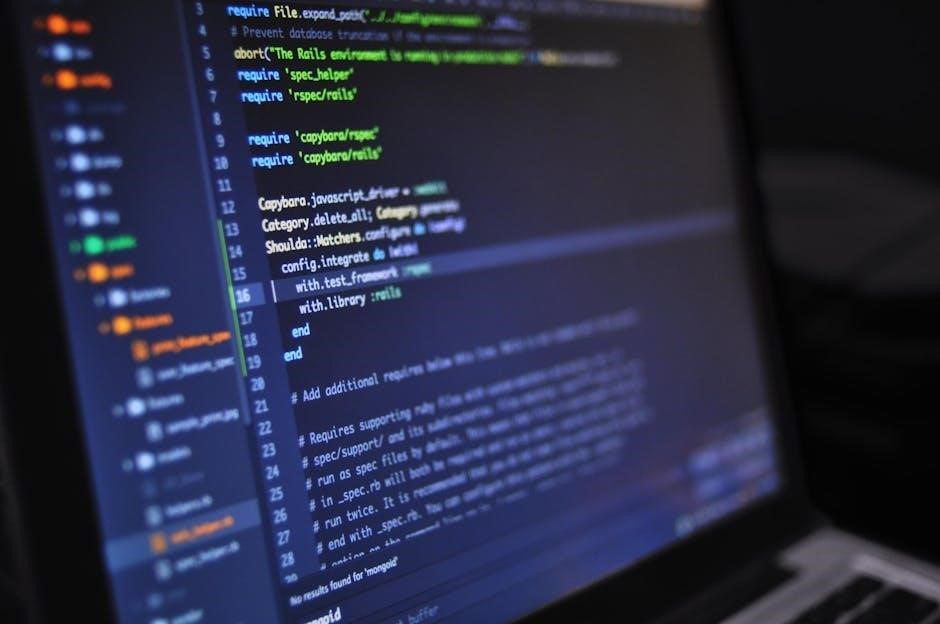guide to computer forensics
Computer forensics involves investigating digital devices with
technical skills
to gather evidence and analyze data‚ using various tools and methods to understand cybersecurity threats and prevent future attacks effectively always.
Definition and Importance
Computer forensics is a scientific method of investigation and analysis to gather evidence from digital devices.
It involves understanding the concepts of computer forensics and applying them to real-world scenarios‚ making it essential in today’s digital age.
The importance of computer forensics lies in its ability to help investigators analyze and present digital evidence in a way that can be easily understood.
This field is crucial in preventing and solving crimes‚ as well as in maintaining cybersecurity.
With the increasing amount of digital information‚ computer forensics has become a vital tool for investigators and examiners.
It provides a systematic approach to investigating digital devices‚ ensuring that all evidence is collected and analyzed properly.
The definition and importance of computer forensics are closely related‚ as the field is defined by its importance in solving crimes and maintaining cybersecurity.
In essence‚ computer forensics is a critical component of modern investigations‚ and its importance cannot be overstated.
It is a constantly evolving field‚ with new technologies and methods being developed to stay ahead of cyber threats.
Getting Started
To get started with computer forensics‚ it is essential to have a basic understanding of computer systems and networks.
A guide to computer forensics can provide valuable information and resources for beginners.
The Internet offers a wealth of information on computer forensics‚ including tutorials‚ videos‚ and online courses.
Getting started with computer forensics can be an intimidating journey‚ but with the right resources and guidance‚ it can be a rewarding and challenging field.
Many online resources provide step-by-step instructions and tips for getting started with computer forensics.
These resources can help individuals understand the concepts and principles of computer forensics and how to apply them in real-world scenarios.
With the increasing demand for computer forensics experts‚ getting started in this field can be a great career move.
It is essential to stay up-to-date with the latest technologies and methods in computer forensics to be successful in this field.
By following a guide to computer forensics and staying committed‚ individuals can develop the skills and knowledge needed to succeed.

Computer Forensics Frameworks
Frameworks provide structure for digital investigations using various tools and methods always effectively online.
PTK Forensics
PTK Forensics is a computer forensic framework for command line tools in the SleuthKit‚ offering a comprehensive set of software modules for digital investigations. This framework provides a structured approach to analyzing digital evidence‚ allowing examiners to efficiently process and examine large amounts of data. With PTK Forensics‚ investigators can perform various tasks‚ including data acquisition‚ analysis‚ and reporting‚ using a single‚ intuitive interface. The framework is designed to be flexible and scalable‚ supporting a wide range of digital devices and platforms. By leveraging PTK Forensics‚ digital forensics professionals can streamline their workflows‚ reduce the risk of errors‚ and improve the overall quality of their investigations. The framework is widely used in the field of digital forensics and is recognized for its reliability and effectiveness in supporting complex investigations. PTK Forensics is a valuable tool for anyone involved in digital forensics‚ providing a robust and efficient means of analyzing digital evidence.
DFF (Digital Forensics Framework)
DFF is a free and Open Source computer forensics software built on top of a dedicated Application Programming Interface (API). It can be used by professional and non-expert people in digital forensics to analyze and investigate digital evidence. The framework provides a comprehensive set of tools for data acquisition‚ analysis‚ and reporting‚ allowing investigators to efficiently process and examine large amounts of data. DFF supports a wide range of digital devices and platforms‚ including computers‚ tablets‚ and smartphones. The software is designed to be flexible and scalable‚ making it a valuable tool for digital forensics professionals. With DFF‚ investigators can perform various tasks‚ including data recovery‚ file analysis‚ and network analysis. The framework is widely used in the field of digital forensics and is recognized for its reliability and effectiveness in supporting complex investigations and providing accurate results. DFF is a powerful tool for analyzing digital evidence.

Investigations and Analysis
Trained examiners analyze data from devices to investigate cybercrimes using various methods and tools effectively always online.
Trained Examiners
Trained examiners play a crucial role in computer forensics‚ as they are responsible for analyzing data from various devices‚ including computers‚ tablets‚ and smartphones. These professionals have the necessary skills and knowledge to extract and examine data‚ and to present their findings in a clear and concise manner. Trained examiners use specialized tools and techniques to investigate cybercrimes‚ and to gather evidence that can be used in legal proceedings. They must be able to work with a variety of operating systems‚ software applications‚ and hardware devices‚ and to stay up-to-date with the latest technologies and trends in the field. By analyzing data and identifying patterns and anomalies‚ trained examiners can help to solve complex cases and bring criminals to justice‚ making them an essential part of the computer forensics process‚ with their expertise being highly valued. They work diligently to uncover the truth.
Presentation of Evidence

The presentation of evidence is a critical step in the computer forensics process‚ as it involves communicating complex technical information to non-technical stakeholders‚ such as judges‚ lawyers‚ and jurors. Trained examiners must be able to present their findings in a clear and concise manner‚ using visual aids and other tools to help illustrate their points. The presentation of evidence must be accurate‚ reliable‚ and admissible in court‚ and must be able to withstand scrutiny and challenge from opposing counsel. Effective presentation of evidence requires strong communication and interpersonal skills‚ as well as the ability to think critically and strategically. By presenting evidence in a clear and compelling way‚ trained examiners can help to build strong cases and achieve justice‚ making the presentation of evidence a vital part of the computer forensics process‚ with a focus on clarity and accuracy always.

Resources and Guides
Various online resources and guides are available to learn computer forensics‚ including books and tutorials always.
Nelson/Phillips/Steuarts GUIDE TO COMPUTER FORENSICS AND INVESTIGATIONS
This guide is a comprehensive resource for learning computer forensics‚ covering topics such as investigation techniques and evidence analysis. The guide is written by experts in the field and provides real-world examples and case studies to illustrate key concepts. It is an essential tool for anyone looking to learn about computer forensics‚ including students‚ professionals‚ and law enforcement personnel. The guide is regularly updated to reflect the latest developments in the field‚ ensuring that readers have access to the most current information and techniques. With its clear and concise writing style‚ the guide is easy to follow and understand‚ making it an ideal resource for those new to computer forensics. The guide also includes instructor resources and online support‚ making it a valuable resource for educators and trainers. Overall‚ the guide is a valuable resource for anyone looking to learn about computer forensics.
A Practical Guide to Digital ForensicsInvestigations
This guide provides a comprehensive and practical approach to digital forensics investigations‚ covering the technical and investigative skills required to succeed in the field. The guide is written in a clear and concise manner‚ making it easy to follow and understand. It covers a wide range of topics‚ including digital forensics for Windows‚ Mac‚ mobile‚ hardware‚ and networks. The guide also addresses online and lab investigations‚ providing readers with a thorough understanding of the investigative process. With its focus on practical skills and techniques‚ the guide is an essential resource for anyone involved in digital forensics investigations. The guide is regularly updated to reflect the latest developments in the field‚ ensuring that readers have access to the most current information and techniques. The guide is a valuable resource for professionals‚ students‚ and law enforcement personnel. It is a complete and practical guide.
